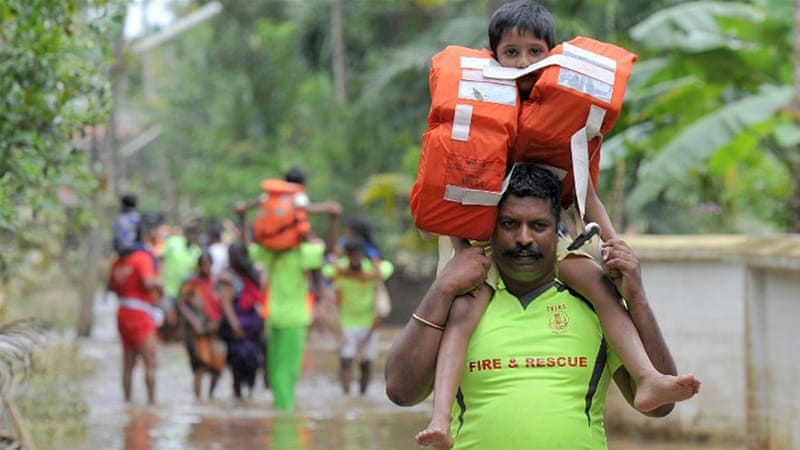More than 800,000 people have been displaced in Kerala, as the death toll from the worst flooding to hit the southern Indian state jumped to at least 370, with losses to infrastructure pegged at almost $3bn.
As the rains subsided on Sunday, relief efforts focused on rescuing those marooned in isolated places for days and airdropping supplies to others, police and officials said.
Kerala has been lashed by torrential monsoon rains since the end of May, triggering landslides and flash floods that have swept away entire villages. Incessant downpours since August 8 have killed more than 190 people and left thousands more stranded.
“In a matter of three to four days, we have been able to move nearly 850,000 people to shelters,” TM Thomas Isaac, Kerala’s finance minister, told Al Jazeera.
“I think the total number of displaced persons, including those who have been moved to relatives’ or friends’ houses, would be well over 1.5 million,” he added in a phone interview from Alappuzha, Kerala.
On Sunday alone, 22,000 people were evacuated from their homes, but a large number of people continue to voluntarily live in flooded houses.
“We saw many people whose ground floors of their homes were knee and waist-deep in the water,” said Al Jazeera’s Andrew Thomas, reporting from Andoor.
“They are living upstairs because they want to stay where they are,” he said,
“So, the overall figure of people whose homes have been flooded and have been affected by this disaster is in the millions,” Thomas added. “It really is a huge disaster in this part of India.”
Unsung heroes
Thousands of army, air force and navy troops, along with the National Disaster Response Force (NDRF), are undertaking the search and rescue operations.
Fishermen from across Kerala have also come together to aid the relief efforts.
“The fisherfolk have played a very remarkable role,” said Isaac, Kerala’s finance minister. “About 500 fisheries boats have been at the forefront of the rescue and shifting operations.
“The fisherfolk have been able to move to interior lakes systems and rivers to help the people.”
On Saturday, fisherman Jaisal KP, a 32-year-old resident of Tanur, rescued three stranded women – one with an infant – in the Malappuram area.
“NDRF personnel who were leading the rescue operations informed us they won’t be able to reach the place where these women were stranded,” Jaisal told Al Jazeera.
“I, along with my co-workers [fishermen], helped them. We have no safety guards or any equipment. We are risking our lives to rescue these people.”
Anunand, 22, who was trapped for four days in Paravoor, was also saved by the fishermen.
“If it wasn’t for them [fishermen], I would’ve died inside the flat,” the graduate student told Al Jazeera in a phone interview.
On Monday, the military will continue to fly helicopters in order to drop aid materials in the more remote communities, Al Jazeera’s Thomas reported.
People wait for aid next to a make-shift raft at a flooded area in Kerala state [Sivaram V/Reuters]
Rebuilding
As of Sunday, two districts out of the state’s 14 were still under red alert.
The Indian government has pledged $71m for flood victims, but Isaac said the state will have to re-negotiate to get a “better deal”.
WATCH: Kerala floods – Thousands displaced as rescue efforts struggle
“One-third of the roads have been completely damaged and the cost of rebuilding them would come over $1bn rupees ($14.3m), so this is a very serious matter.”
Around 100,000 houses will also have to be rebuilt and large amounts of plastic rubbish – comprising mostly water bottles provided in aid packages and washed away by the floodwaters – will have to be cleared out, he added.
The state government will reach out to multinational agencies to rebuild the water systems, Isaac said.
“This calamity also points to some serious imbalance in development and the environmental consideration,” the finance minister added.
“Hope this disaster will prompt us to pick a more sustainable development path.”
The amount of rain that has fallen is unexpectedly high this year, according to Al Jazeera’s senior meteorologist Steff Gaulter.
“Normally, by this point in the monsoon season, we expect to see about 1,649mm of rain. But this year it was 2,344mm. This is well over what we’d expect in the entire monsoon season, and we still have another month to go,” she said.
[SOURCE: Al Jazeera News]





 WhatsApp us
WhatsApp us 

